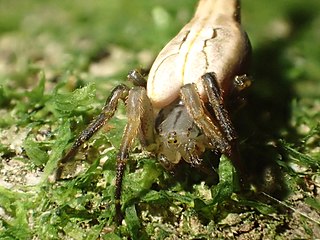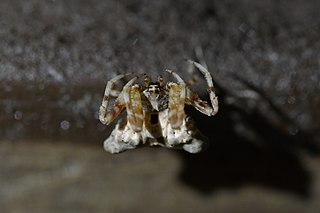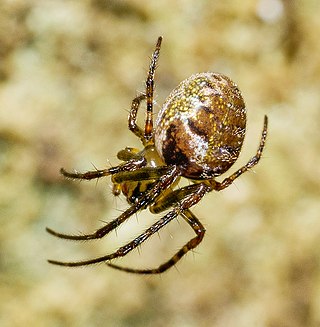
Trite auricoma, commonly known as the golden-brown jumping spider, is a species of jumping spider endemic to New Zealand.
Kapitia is a genus of spiders in the family Oonopidae. It was first described in 1956 by Forster. As of 2024, it contains only one species, Kapitia obscura.

Diaea ambara is a species of crab spider that is endemic to New Zealand.

Acroaspis decorosa is a species of orbweaver spider that is endemic to New Zealand.

Arachnura feredayi, the tailed forest spider, is endemic to New Zealand. it is known for the distinctive tapering body shape in females which are also much larger than males, and for producing vertical columns of eggsacs in the 12 o'clock position in their webs.
Cantuaria magna is a species of trapdoor spider endemic to New Zealand.
Migas cantuarius is a species of Mygalomorph spider endemic to New Zealand.
Ariadna bellatoria is a species of tube-dwelling spider endemic to New Zealand.
Ariadna septemcincta is a species of tube-dwelling spider endemic to New Zealand.
Tangata orepukiensis is a species of Orsolobidae. The species is endemic to New Zealand.

Celaenia olivacea is a species of Araneidae spider that is native to New Zealand.
Celaenia penna is a species of Araneidae spider that is native to New Zealand.
Celaenia tuberosa is a species of Araneidae spider that is endemic to New Zealand.

Cryptaranea atrihastula is a species of orb-weaver spider that is endemic to New Zealand.
Cryptaranea venustula is a species of orb-weaver spider that is endemic to New Zealand.

Cyclosa trilobata is a species of orb-weaver spider that is native to New Zealand and Australia.

Courtaraneus orientalis is a species of Araneidae that is endemic to New Zealand. It is currently the only species in Courtaraneus, which was described in 2022.
Tetragnatha multipunctata is a species of Tetragnathidae spider that is endemic to New Zealand.
Tetragnatha nigricans is a species of Tetragnathidae spider that is endemic to New Zealand.

Taraire rufolineata is a species of Tetragnathidae spider that is endemic to New Zealand.









